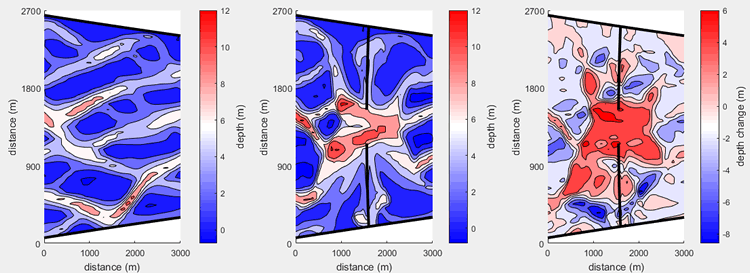D.J.K. Schuurman1*, M. van der Vegt1, J.R.F.W. Leuven2
1 Utrecht University,
2 Royal HaskoningDHV,
Introduction
Estuaries are morphological dynamic features, positioned on the edge between river and sea. The morphodynamic evolution is the result of continuous interaction between the available sediment and the nonlinear tidal propagation giving rise to residual sediment transport patterns. There is an increased need for renewable energy and tidal energy generation in estuaries might be a viable option. Although tidal energy has big advantages over solar and wind energy (reliability), investments fall behind because full exploitation of the tidal resource is hindered by the limited amount of knowledge on impacts of tidal barrages on estuarine morphodynamics. This study aims to investigate the impacts of a tidal barrage on estuarine scale morphologic evolution. A tidal barrage will locally reduce the cross-sectional area and can reduce the effective basin length. This will impact the flow velocities, tidal prism, and force the system out of morphodynamic equilibrium.
Results
First, a 2DH Delft3D morphodynamic model with an idealized estuary geometry was used to model the morphodynamic response of the estuary to cross-sectional area reduction, as a consequence of tidal barrage implementation. To keep things simple, the effects of waves are neglected and river inflow on the landward end of the estuary was kept constant. Results show strong channel deepening near the barrage, but relatively static patterns of channels and shoals further away. Morphological response near the barrage is initially strong but quickly slows down over time, while morphological response further away from the barrage occurs later and is less prominent as it takes time for morphological change to translate over distance. Sensitivity runs in which we tested the location of the barrage show that the closer to the mouth, the larger the immediate measurable response in channel depth.
Next, a 1D hydrodynamic model was used to solve basic shallow water equations for tidal wave propagation through channels and its result on water level amplitude, flow velocity amplitude and tidal asymmetry. Using that model, we studied the effect of the tidal barrage on tidal range, tidal prism and tidal asymmetry for a wide range of forcing conditions and for different positions of the barrage in the estuary. For an estuary of the modelled size and depth, the tide shows a decrease in ebb-dominance over distance compared to the control run without barrage placement. More results of that analysis will be presented during the NCK days.

Figure 1 Bathymetry of Delft3D model runs without cross-sectional area reduction (left), and with (middle), and map showing the difference between the two with erosion in red and deposition in blue (right), duration=30 years
I. Surname1*, F.N. Another-Surname2 , Y. Next-Surname2
1 University Name, Country; 2 Organization Name, Country
* Corresponding author: mail.name@organization.org


